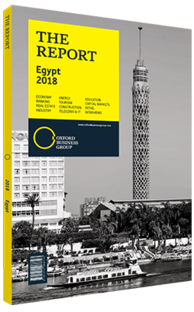Infrastructure demand in Egypt set to keep industrial production levels high
Egypt’s construction sector continues apace, and cement production levels have been largely sustained to support ongoing infrastructure, commercial and residential projects. Despite challenges, the cement industry – the 12th largest in the world in 2016, according to international bank HSBC – is set to maintain this growth trend in the coming years.
Moving Forward
“The boom in construction in Egypt has helped lead to increased demand for building materials,” Ahmed Hafez, chairman and managing director of Ideal Standard International Egypt, told OBG. As reported by the International Finance Corporation (IFC), Egypt operates 25 cement plants, including 12 that are locally owned and 13 subsidiaries of international firms. Together, the firms produce the equivalent of 64% of the installed capacity.
Medhat Stefanos, head of the cement production division at the Federation of Egyptian Industries, told local press in May 2017 that the cement industry aims to further increase production capacity to 84m tonnes by 2020, up from the estimated 60m tonnes in 2017.
New Deals
Various developments involving both Egyptian and international players are currently under way. Egyptian Electro-Mechanical Design Group announced plans to build a $300m plant in the Fouka area in Mersa Matruh, while the Egyptian Arabian Cement Company intends to invest over LE130m ($8.6m) to increase the efficiency of its production process. El Sewedy Cement Company, meanwhile, awarded global engineering firm FLS midth an order for engineering, procurement and supply of equipment for the expansion of one of its production lines in Ain Sokhna, which is expected to be completed by the end of 2018. According to a 2016 report from Egyptian investment bank Pharos Holding, the state signed a €1.05bn deal with China-based Sinoma Cement to create six new production lines, adding 12m tonnes per annum to existing supply, representing 18.7% of Egypt’s expected production capacity.
Moreover, the Industrial Development Authority put forward 14 operating licences for grey cement in 2016, awarding licences to El Sewedy Electric for an Ain Sokhna project, South Valley Cement Company for a development in Beni Suef and El Masryeen Cement for a Sohag project. The remaining cement licences will be issued in several areas, including Mersa Matruh, South Sinai, Suez, Minya and Aswan.
Ongoing Challenge
In June 2017 Egypt hiked fuel prices by up to 50% to help meet the terms of a $12bn IMF loan deal. This was particularly hard on cement producers, which already lost energy subsidies in 2014. Fuel oil prices for cement factories were raised by 40%, from LE2500 to LE3500 ($165 to $231) per tonne, and electricity prices increased for industry across the board. In addition to these increases, buying and transporting coal – a key source of fuel in cement plants – caused additional strain, even though coal was initially supposed to provide a cheaper, albeit less environmentally friendly, power alternative. These factors combined, developers reported that the cost of raw materials had increased by 300% since 2015.
In January 2017 Ahmed Al Zaini, chairman of the building materials division at the Federation of Egyptian Chambers of Commerce, told regional press, “Prices of some steel and cement products have jumped by nearly 100%. This will negatively affect projects and put pressure on some contracting firms, who could be forced out.” Long term, part of the solution to this challenge may come in the form of locally produced alternative fuels. According to the 2016 IFC report “Unlocking Value: Alternative Fuels for Egypt’s Cement Industry”, when processed at scale, alternative fuels and raw materials could be up to 40% less expensive than coal.
Additionally, despite short-term challenges, particularly in terms of cost-effective power, the IFC estimates that demand for clinker in Egypt is expected to rise from 49m tonnes in 2015 to 72m tonnes in 2025.
You have reached the limit of premium articles you can view for free.
Choose from the options below to purchase print or digital editions of our Reports. You can also purchase a website subscription giving you unlimited access to all of our Reports online for 12 months.
If you have already purchased this Report or have a website subscription, please login to continue.

